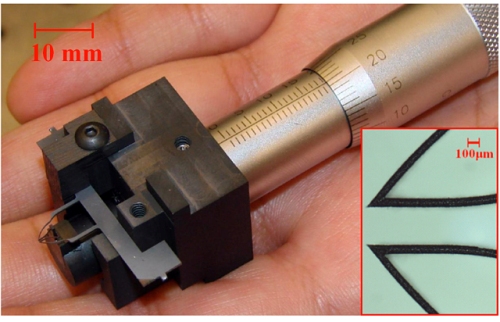Scientists from Purdue University have developed novel microtweezers that can be used to manipulate objects to construct small structures such as MEMS, apply coatings to create sophisticated sensors and collect and locate live stem cell spheres onto analytical sensors and devices for research.
 Scientists from Purdue University have developed novel microtweezers that can be used to manipulate objects to construct small structures such as MEMS, apply coatings to create sophisticated sensors and collect and locate live stem cell spheres onto analytical sensors and devices for research. (Birck Nanotechnology Center photo)
Scientists from Purdue University have developed novel microtweezers that can be used to manipulate objects to construct small structures such as MEMS, apply coatings to create sophisticated sensors and collect and locate live stem cell spheres onto analytical sensors and devices for research. (Birck Nanotechnology Center photo)
A graphite interface, a silicon-based two-pronged tweezer and a thimble knob are the major components of the new tool. The thimble knob’s turning motion is converted by the graphite interface to a pulling-and-pushing action for opening and closing the prongs of the tweezer. The tool eliminates the use of electrical power sources, thus widening its use for practical applications. Its design featuring a one-piece ‘compliant structure’ is simple to produce and operate, according to one of the researchers, Cagri Savran.
Savran stated that the research team is now involved in accurately measuring the weight of individual micro particles in order to determine their properties and compositions. The microtweezers can be used to functionalize ‘microcantilevers’ by coating specific proteins or chemicals to sense the presence of chemicals in water and air. A microcantilever can be functionalized to detect different materials at once thanks to the microtweezer’s capability to microprint a series of accurately located dots of various chemicals on every cantilever. This sensing technology may also need a trace amount of sample for analysis when compared to traditional diagnostic technologies.
The novel microtweezers can easily be fixed to ‘translation stages,’ which are platforms wherein specimens are mounted for viewing and manipulating. Savran commented that the tiny and portable tool can also be removed easily, while still clasping the test sample.